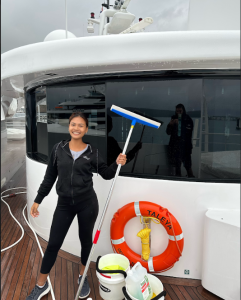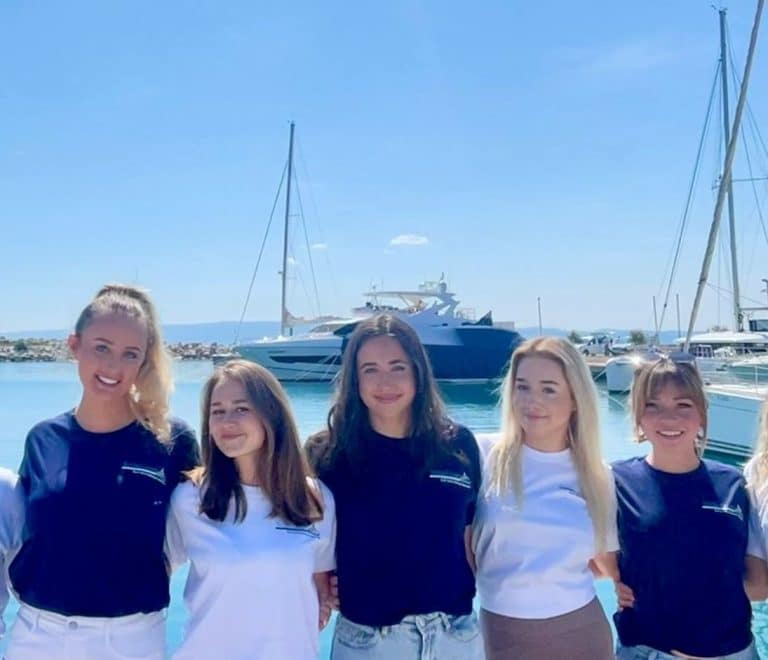What is a Deckhand?
A deckhand handles cleaning, basic maintenance, and cargo. It's an entry-level role in maritime work with room for career growth.
A deckhand is an entry-level position in the maritime industry. Deckhands play an essential role in the regular operations and maintenance on the ship or boat.
This article will cover what a deckhand is responsible for, and the process to get started.


Deckhand Responsibilities
Most of the deckhand responsibilities include ensuring everything on the vessel is clean and in good working condition. When you’re starting out as a new deckhand, you can expect to spend a lot of time cleaning, handling basic maintenance tasks, and keeping watch.
Deckhands work under the supervision of the vessel’s Deck Officers.
As you spend more time and gain more experience, you’ll take care of other tasks around the vessel.
The specific responsibilities also depend on the type and purpose of your vessel.
Some general responsibilities include:
- Securing cargo and gear.
- Standing watch underway and in port.
- Maintaining ship equipment and machinery on the decks.
- Maintaining deck surfaces and interior spaces.
- Assisting in operations like docking and undocking.
- Ensuring the safety of passengers and other crew members.
Working as a deckhand can be a physically demanding job, and you should expect to be on your feet most of the time. You may also be working long hours, and away from home depending on your schedule.
Certifications
Starting out in the maritime industry typically doesn’t require advanced education or years of experience.
It’s possible to start working as an uncertified/unqualified deckhand with little to no training. We always recommend this if you’re not sure about entering the maritime industry. Working as an unqualified deckhand will give you a taste of what it’s like before you invest your time and money into a formal maritime training program.
The entry-level position is called Ordinary Seaman, or OS. Becoming an OS is a fairly straightforward process. You’ll need to complete a few Coast Guard forms, get a TWIC , pass a drug test , and a general USCG physical exam.
You can read more about that process in this article: How to Become an Ordinary Seaman
If you have some experience and sea days, you can work your way upward to become an Able Seaman. As you spend more time in the industry and earn more certifications, you’ll have better career and pay opportunities.
General skills required
Working in the deck crew isn’t rocket science, and nearly all of your training will be on the job.
You can expect to be on your feet, moving around, and doing some physical work. Being in decent shape will definitely make your job easier.
Good communication skills are also needed in the maritime industry. You’ll usually be working with a team, but everyone is expected to pull their own weight. Understanding what’s expected of you is essential.
You’ll also want to audit your mental toughness. Working in this industry won’t be a walk in the park, especially when you’re coming in at an entry-level position. You need to be able to handle the hard work, being alone and possibly away from home, and stressful situations.
Career Path
If you decide to pursue a career in the maritime industry, there are many different paths you can take that all start with being a deckhand.
Inland and Near Coastal
Inland vessels travel on rivers, bays, and coastal waters. Near Coastal vessels stay within <200 nautical miles from shore. Inland or near coastal work typically means you’ll travel less and have less time away from home.
A lot of these vessels are smaller, but they still require deckhands with different qualifications depending on what kind of work they are doing.
Some Inland and Near Coastal vessels don’t always require you to have a USCG Merchant Mariner Credential (MMC) which is also called an entry level USCG license to be a deckhand. These include:
- Passenger ferries
- Smaller fishing boats
Other Inland and Near Coastal vessels typically require you to have a USCG Merchant Mariner Credential (MMC) which is also called an entry level USCG license and a TWIC to be a deckhand. These include:
- Support/Service vessels
Ocean-going vessels
Another option is to work on larger ocean-going vessels. This work comes with a much different opportunity and schedule. The ocean voyages can last weeks or months, so you can expect to be away from home more often. These vessels typically require you to have a USCG Merchant Mariner Credential or entry level USCG license and a TWIC.
These include:
- Cargo ships
- Cruise ships
- Research vessels
As you can imagine, the deckhand work on a cruise ship is much different than the deckhand work on a cargo ship. Cruise ship deckhands are working in customer service. On a cargo ship, deckhands are helping the other crew members.
You can get a job as an unqualified deckhand without years of training, but you will need to get your TWIC card to work on ocean-going vessels. Working in international waters also requires getting your STCW endorsement. Different STCW endorsements allow you to do a variety of jobs aboard merchant vessels.
Continued training and education
There are plenty of opportunities to add courses and certifications to your maritime resume. When you’re starting out as a deckhand, one of the most important things to get is more sea time. The more time you spend on the water, the more you’ll learn and the more opportunities you’ll have access to.
To become an Able Seaman, you’ll need a minimum of 180 sea days working in the Deck Department. You’ll also need to pass a written exam and practical demonstration requirements for Able Seaman and Lifeboatman . We recommend that you take a course at a USCG approved school for both Able Seaman and Lifeboatman.
There are also higher Able Seaman ratings. The highest of these is Able Seaman Unlimited, which requires 1080 days of seatime working on the Deck Department on Oceans, Near Coastal or Great Lakes waters.
As you can see, moving up the ladder in the maritime industry won’t happen overnight. There are great career opportunities, but they require hard work and patience. It’s recommended that you explore your options and decide which ladder you want to climb.
For example, a Wiper is an entry-level position. From there, you can work your way up to becoming a QMED (Qualified Member of the Engine Department) and work as an engineer on supporting the maintenance of the vessel's mechanical systems.
There are plenty of different entry-level careers, and many of them can start with becoming a deckhand and getting your first few years of experience. With this experience you can take advanced courses to work your way up to becoming a Captain on Smaller vessels and eventually Master Unlimited, which is the highest rank in the maritime industry.

We hope this made your life a little easier and if you have other questions the MM-SEAS team is always here to help!
MM-SEAS is free to use on your own and if you need some more personalized help you can upgrade to MM-SEAS Pro inside of the site.
No matter what, when you are ready to submit your application, you can choose to have the MM-SEAS staff create a perfect application, handle the USCG application fees and work with the USCG on your behalf to resolve any issues for a flat fee of $349 or you can choose to submit on your own.
Pro MM-SEAS members get access to unlimited live 1 on 1 calls with one of our USCG Licensing Specialists. We've found that answering questions live with screen sharing in a video call makes both of our lives easier. Pro MM-SEAS members can access these features inside of MM-SEAS under License Guidance.
Need to renew, upgrade or get your first USCG license? We're here to help.
About the author.

Nate has over 15 years of professional maritime experience and has hawsepiped his way to a 3rd Mate Unlimited Endorsement with full STCW compliance. He is proud veteran of the NOAA Commissioned Corps.


- Member Login
- Connect with Us
- Like us on Facebook
- Follow us on Twitter
- Sign Up For Our Jobs Newsletter
The actual functions of a cruise ship are performed by the Deckhands & Engineers – they are the ones that do much of the work. The deckhands work primarily around the ship and on the deck, and the engineers focus on the engine room of the ship.
Deckhands are the general handymen of the ship. They perform all work that is largely non-technical in nature. This includes painting, cleaning floors, carpentry, varnishing, securing ship at dock, and anything else that is needed.
Engineers are in the Engine Department and it is their job to make sure the engines are working efficiently – and just about any other machinery or mechanical systems on the ship. They also work on the power generation systems, the heating and cooling systems, refrigeration systems, electrical systems, elevators, and more. Besides this, they may also help with meal preparation.
Deckhand positions are often entry level with few requirements, but special talents, such as carpentry, may be required – depending on the expertise needed. Engineers, however, need to have a qualifying education and experience. Assistant Engineers are an entry-level position.
To view the rest of this page, you will need to be a Premium Member.You are visiting the Members Section as a Free BASIC Member . You will only have access to a limited amount of Job Hunting Tools and Content. For full access you will need to upgrade to a PREMIUM MEMBERSHIP. Upgrade Today
Engineering Department Jobs
You are visiting the Members Section as a Free BASIC Member . You will only have access to a limited amount of Job Hunting Tools and Content. For full access you will need to upgrade to a PREMIUM MEMBERSHIP.

Setting Sail to Success: A Guide to Becoming a Successful Deckhand and Building a Rewarding Maritime Career
- June 23, 2023
Imagine standing on the deck of a ship, feeling the ocean breeze on your face and the rolling waves beneath your feet, as you embark on an exciting journey across the vast seas. If this sounds like a dream come true, then a career as a deckhand might be the perfect fit for you. In this article, we will guide you through the essential steps to become a successful deckhand, from acquiring the necessary skills and qualifications to building your professional network in the maritime industry. We will also share valuable tips for landing your first deckhand job on a vessel and discuss opportunities for growth and development in this rewarding career. Lastly, we will address the importance of staying safe and adapting to life at sea as a deckhand. So, get ready to set sail on a thrilling adventure as we navigate the path to becoming a deckhand.
1. Essential Skills and Qualifications for a Successful Deckhand Career
Embarking on a career as a deckhand requires a specific set of skills and qualifications to ensure success in this demanding profession. One of the most crucial abilities is having a strong work ethic, as deckhands often work long hours in challenging conditions. Additionally, being a team player is vital, as deckhands must collaborate with other crew members to maintain the vessel and ensure smooth operations. Physical fitness is also a significant factor, as the job entails heavy lifting and manual labor. Furthermore, possessing excellent communication skills and a keen attention to detail will help you excel in this role.
When it comes to qualifications, obtaining a STCW (Standards of Training, Certification, and Watchkeeping) certificate is essential for working on commercial vessels. This internationally recognized certification covers basic safety training, first aid, and firefighting. Additionally, having a Powerboat Level 2 license or a Yachtmaster qualification can be advantageous, as it demonstrates your competency in operating small vessels. While there are many pros to a deckhand career, such as the opportunity to travel and work in a dynamic environment, it’s essential to consider the cons, such as the physical demands and long hours away from home. Ultimately, a successful deckhand career requires dedication, hard work, and a passion for the maritime industry.
2. Acquiring the Necessary Training and Certifications for Deckhands
Before you can begin your journey as a deckhand, it’s essential to acquire the appropriate training and certifications. Many maritime schools and training centers offer courses specifically designed for aspiring deckhands. These courses typically cover essential skills such as knot tying, line handling, safety procedures, and basic navigation. Additionally, you may want to consider taking specialized courses in areas such as firefighting, first aid, and personal survival techniques.
When it comes to certifications, there are a few key ones that you’ll need to obtain to work as a deckhand. These include:
- STCW (Standards of Training, Certification, and Watchkeeping) Basic Safety Training: This internationally recognized certification covers basic safety training in personal survival techniques, fire prevention and firefighting, elementary first aid, and personal safety and social responsibilities.
- ENG1 Medical Certificate: This certificate confirms that you are medically fit to work at sea and is required by most employers.
- Proficiency in Designated Security Duties (PDSD): This certification is required for crew members with specific security responsibilities on board a vessel.
Once you have completed the necessary training and obtained the required certifications, you’ll be well-prepared to start your career as a deckhand. Networking and gaining practical experience through internships or entry-level positions will also be crucial in helping you secure a job in the industry. Remember, becoming a successful deckhand takes time, dedication, and a willingness to learn and grow in your role.
3. Building Your Professional Network in the Maritime Industry
In order to become a successful deckhand, it is crucial to build a strong professional network within the maritime industry. This can be achieved by following these steps:
- Attend industry events such as conferences, workshops, and seminars to meet like-minded professionals and learn about the latest trends and opportunities in the maritime sector.
- Join professional associations and organizations related to the maritime industry, as they often provide networking opportunities and access to valuable resources.
- Utilize social media platforms like LinkedIn to connect with professionals in the industry and showcase your skills and experience.
- Consider volunteering or interning with maritime companies or organizations to gain hands-on experience and make valuable connections.
- Don’t be afraid to reach out to professionals you admire for advice or mentorship, as they can provide invaluable insights and guidance on your career path.
By actively engaging in these networking activities, you will be better positioned to find job opportunities and establish a successful career as a deckhand in the maritime industry.
4. Tips for Landing Your First Deckhand Job on a Vessel
Securing a position as a deckhand on a vessel can be a challenging yet rewarding experience. Networking is crucial in this industry, so make sure to attend boat shows, yacht clubs, and marinas to meet potential employers and other professionals in the field. Additionally, consider joining online forums and social media groups related to the maritime industry to expand your network and stay informed about job opportunities.
Obtaining relevant certifications can significantly increase your chances of being hired as a deckhand. Some of the essential certifications include the Standards of Training, Certification, and Watchkeeping (STCW), and the Powerboat Level 2 certificate. Additionally, having a strong background in water sports, such as sailing or diving, can be a valuable asset. Remember to highlight these skills and certifications on your resume and during interviews.
Lastly, gaining hands-on experience is vital for aspiring deckhands. Volunteering on boats or working at marinas can provide you with practical knowledge and skills that will be useful in your future career. Moreover, these experiences can serve as excellent references when applying for deckhand positions. Be prepared to start at an entry-level position and work your way up, as this will demonstrate your commitment and passion for the maritime industry.
5. Advancing Your Deckhand Career: Opportunities for Growth and Development
As a deckhand, it is essential to continuously improve your skills and knowledge in order to advance in your career. One way to achieve this is by attending specialized training courses and obtaining relevant certifications. For instance, you can pursue courses in navigation, marine engineering, or even yacht management. Additionally, participating in workshops and seminars related to the maritime industry can help you stay updated on the latest trends and best practices. It is also crucial to network with professionals in the field, as this can open up new opportunities for growth and development.
A checklist for advancing your deckhand career may include the following items: obtaining necessary certifications, attending training courses, participating in industry events, networking with professionals, and gaining experience in various roles on board. By focusing on these areas, you can enhance your expertise and increase your chances of securing higher-level positions, such as a bosun, mate, or even captain. Remember that hard work, dedication, and a willingness to learn are key factors in achieving success in the maritime industry.
6. Staying Safe and Adapting to Life at Sea as a Deckhand
Adapting to life at sea as a deckhand requires a strong focus on safety and the ability to quickly acclimate to the unique challenges of working on a vessel. One of the most crucial aspects of staying safe on board is having a thorough understanding of the ship’s safety procedures and equipment. This includes knowing the location and proper use of life jackets, life rafts, fire extinguishers, and emergency signals. Additionally, it is essential to participate in regular safety drills and maintain a checklist to ensure all safety equipment is in good working order.
Physical fitness and stamina are also vital components of a deckhand’s ability to stay safe and adapt to life at sea. The demanding nature of the job requires long hours of manual labor, often in challenging weather conditions. Regular exercise, proper nutrition, and adequate rest are essential for maintaining the physical and mental resilience needed to perform at a high level. Furthermore, it is crucial to be aware of one’s surroundings and maintain clear communication with fellow crew members to prevent accidents and ensure the smooth operation of the vessel.
Lastly, adapting to life at sea as a deckhand involves developing a strong sense of camaraderie and teamwork with fellow crew members. Living and working in close quarters can be challenging, but it is essential to maintain a positive attitude and foster a supportive environment. This includes respecting the privacy and personal space of others, being willing to lend a hand when needed, and actively participating in shared responsibilities such as cooking and cleaning. By cultivating a strong sense of teamwork and maintaining a focus on safety, deckhands can successfully navigate the challenges of life at sea and excel in their roles.
Frequently Asked Questions
1. what are the typical daily tasks of a deckhand, 2. how long does it take to become a qualified deckhand, 3. what are the physical requirements for a deckhand, 4. are there any specific certifications required to work as a deckhand, 5. what is the typical career progression for a deckhand.

Yacht Deckhand Premium STCW

Yacht Stewardess Premium STCW

Yacht Stewardess Full STCW

Superyacht Deckhand Full STCW

Top 10 best places to find a Yacht job in the Med 2024?

How to Become a Yacht Deckhand Australia

Yacht Stewardess Job Germany

How to Become a Yacht Stewardess in Australia?

Where can I find a Yacht job ?

Do I need a visa to work on Superyachts ?

Dockwalking Yacht Crew guide
Superyacht crew training europe.

30% Off only during April on all Deckhand and Stewardess Training only.
Get free yacht cv and yacht job offers

- Course Calendar
If you’re interested in the idea of working on the water, becoming a deckhand is the best way to enter the maritime industry — it’s a unique career path that offers exciting and rewarding opportunities. The Bureau of Labor Statistics projects that the demand for water transportation workers will only grow over the coming years.
Throughout this article, we’ll cover everything you’ll want to know about:
How to Become a Deckhand on a Boat or Large Ship
Merchant mariner positions and duties, types of jobs you can have as a deckhand, average salary of a deckhand, benefits and disadvantages of being a deckhand, mitags for maritime training.
There are several different types of jobs that fall under the ‘deckhand’ category, and your duties and experience as a crew member will vary greatly depending on what kind of vessel you work aboard.
In this quick guide, we’ll take you through how to get into the maritime industry, what it’s like to work as a deckhand and some of the benefits and disadvantages of working on the water.
Do you have a good work ethic and are interested in working on boats or large ships — but you don’t know where to begin? How do you become a deckhand with no experience?
You can either apply for entry-level unqualified deckhand positions or attend a maritime training school.
Apply for Unqualified Positions

Many people get into the maritime industry by applying for jobs as deckhands that don’t require any specialized training or licenses. These jobs are usually aboard inland vessels — meaning those that don’t operate in the ocean.
Getting a deckhand job that doesn’t require certifications or a license is a great way to explore what it's like to work in the marine industry. Just because you aren’t working aboard a large ship doesn’t mean you’re wasting your time — you can document your hours of work aboard any vessel and use that sea time to earn licenses and certifications that will advance your career. Also, you’ll gain valuable basic knowledge of vessel operations.
What if you know for sure that you want a career in the maritime industry, though?
If you know that a career on the water is for you and you want to work aboard large ships, then there’s no better way to get a job and enter the industry than maritime training.
Questions? Contact a school advisor here.
Enroll in a Maritime Training Program
Maritime training programs teach you the skills and the knowledge you need to start a career on a large merchant vessel, as well as a good understanding of maritime safety practices.
When you go through these programs, you fast-track your maritime career and can start to climb the professional ladder more quickly.
Training programs are best for those who want to work aboard large vessels like cruise or container ships and work their way up to eventually become a senior deck officer, engineer or captain.
There are several different career paths open to you if you want to work aboard large ships, and there are specialized education paths to help you reach each of them.
On a day-to-day basis, a deckhand’s role can be very different — depending on the type of vessel you work aboard and what your position on that vessel is.
In general, deckhands are responsible for maintaining the cleanliness of a vessel and its mechanical, on-deck equipment. To do this, they must have a basic understanding of vessel operations and best practices to protect passengers, cargo and the environment.
Let’s get into the different duties deckhands may have in various positions in the maritime industry, as well as jobs you could work your way up to.
Deckhands operate and maintain equipment on the deck of a vessel and assist with docking and other operations. The deckhands together make up the deck crew and are responsible for maintaining the ship — other than the engine and other systems that are the responsibility of onboard engineers.
The lowest level of certified deckhand on large ships is called an Ordinary Seaman, or OS. Some large ships have a Chief Officer in charge of deckhand supervision called the boatswain.
The duties of deckhands will vary greatly depending on the size and function of the vessel, but some of their general duties include the following:
- Stand watch and look for other boats and dangerous obstructions in the water, as well as navigational aids like buoys or markers.
- Operate and maintain onboard equipment
- Maintain deck surfaces — resurfacing and painting
- Handle lines and assist with berthing and unberthing
- Secure cargo on deck and towing
- Help unload and load cargo
- Follow the Captain’s orders and help senior deck officers
- Ensure the safety of passengers and crew members
- Ensure best environmental practices while working
- Help steer the vessel and monitor water depth — this is more common on smaller vessels
- Clean the inside crew quarters of the ship — unless on a large vessel with stewards
If you earn maritime certifications through a training school, you can begin to work your way up in the ranks to higher positions. The first of these you may strive for is a deck officer, also known as a mate.
Deck Officers
Deck officers help direct the operation of a ship alongside the Captain. There are typically three levels in this particular maritime career path, and each is assigned their own duties:
- The chief mate generally is in charge of cargo management operations.
- The second mate is in charge of navigation and watchkeeping.
- The third mate is in charge of vessel and passenger safety.
Mate positions are what most deckhands aboard large ships strive to become — they are prestigious achievements and come with a significant increase in salary. With maritime training programs, deckhands can rise through the ranks quickly to higher positions.
Deck officers are expected to do the following:
- Keep a navigational watch alongside other crew members and the captain
- Supervise and direct deck crew for different operations
- Supervise and assist with the docking of the ship
- Monitor navigational equipment, navigational aids and plot safe courses
- Determine and control the speed of the vessel
- Inspect cargo and ensure it is correctly stowed by crew members
- Make announcements to crew and passengers
- Ensure environmental compliance and safety
- Supervise and maintain safety equipment and practices

Ship's Engineer
After you gain some experience as a deckhand, another path you may choose to pursue is becoming a ship’s engineer. If you love practical work with engines and mechanical systems, this could be an excellent opportunity.
Ship engineers are responsible for maintaining a vessel’s propulsion system — in other words, the engine, boilers, pumps, electrical systems and other machinery. Small vessels may have one or even no engineer, but large ships will have several. Like the deck department, the engineering sector of a ship has a hierarchy, with a chief engineer and lower-level officers.
As an engineer aboard a ship, you may be responsible for the following:
- Maintenance of propulsion, electrical, refrigeration and ventilation systems
- Operation of the ship’s engine according to the captain’s orders
- Recording mechanical information like services and routine inspections
- Daily maintenance checks
- Calculating and monitoring fueling and fluid changes as well as maintenance needs

As we mentioned before, there are several different types of vessels you can work aboard as a deckhand, and the right one for you will depend on your personality. It’s best to explore the different types and determine your ideal path before you try to enter the maritime industry to ensure your experience lines up with your career goals.
When you know the type of work you’ll be doing aboard certain vessels and what your schedule will be like, you can make a more informed decision as to which one is right for you.
There are two broad categories in the maritime world — near coastal/inland vessels and offshore vessels. Here's a look at the two types and what jobs they offer.
1. Inland and Near Coastal Vessels
If you want to join the maritime industry but don’t like the idea of being away for months at a time, working aboard a vessel that stays near shore might be the best choice for you. There are several types of inland/near coastal vessels with deckhand jobs in this category, and these are some of the popular ones:
- Ferries : You can work as a deckhand collecting money from passengers and transporting them and their cars across waterways.
- Tour boats : If your harbor or lake has an interesting background or sights that draw tourists, you may be able to work aboard a tour boat to gain your first boating experience.
- Service vessels : You may be able to get a job aboard a vessel that offers a cleaning service, pump out service or fuels larger vessels in a harbor or marina.
- Sport fishing boats : If you love to fish and want to help other enthusiasts on angling adventures, working on a fishing boat may be an exciting path for you. You typically will be away for a few days to a few weeks.
- Barges : There are several different barge operations and jobs for the deckhands who work aboard them. Barges can be used for dredging, salvage, the transport of marine cranes and other construction equipment, and support purposes.
- Tugboats : Becoming a tugboat deckhand is no small task. Those who commit to this industry must undergo years of training to understand the skilled and complex functions of these important vessels. However, tugboat crew members and captains are known to make handsome salaries once they put in their time in the sector.
Inland/near coastal maritime careers can still offer good salaries. It’s merely a matter of preference in career style.
2. Offshore Vessels
If you like the idea of traveling long distances and seeing the world on a ship, then offshore vessels might be the better choice for you. People can spend months at a time at sea, followed by long periods of time off and competitive salaries. This career offers an alternative schedule to the traditional nine-to-five, good pay and the opportunity to travel and work on the water — just a few of the reasons people love working aboard large offshore vessels.
These are a few of the most popular kinds of offshore ships you can work aboard:
- Cargo ship : Perhaps the most common option for offshore vessels, cargo ships transport goods across the world. These vessels have several crew members that live aboard the ship for months at a time while they work and earn their salary in a condensed work schedule.
- Research vessel : These vessels lead expeditions across the world's oceans to advance science and gain knowledge. You may travel to remote locations and help your team with interesting and vital oceanographic research.
- Cruise ship : These guest-oriented vessels offer a more social environment than cargo ships and a different working experience. If you decide to work aboard a cruise ship, you’ll get to see exotic locales around the world and get paid as you go.
Payscale reports the average annual salary for a deckhand to be between $27,503 and $60,432.
The average salary of a deckhand varies significantly based on the job you get. Some of the lower-level jobs that don’t take any prior experience or training are obviously on the lower end of the pay scale and can be minimum wage.
On the other hand, if you go through maritime training programs and become a deckhand on a large ship or specialized vessel like a tugboat, your salary will be significantly higher. You’ll also have the opportunity to work your way up the ranks for significant pay increases.
Just like any traditional job, working at sea comes with its own drawbacks. Here are few:
- Being away from home : Long periods away from home on larger vessels isn’t for everyone, and you either have to choose a ship that doesn’t go on extended trips or be alright with this type of work schedule.
- Manual labor : Being a deckhand means getting your hands dirty. You have to do the ‘nitty gritty’ aboard your vessel. But, once you pay your dues and work your way up the ranks, you’ll do less and less of that kind of work and focus more on crew supervision.
- Extended hours : With an alternative schedule, it can sometimes mean you’ll have to work long hours. However, it can mean earning overtime and getting more of your weekly work out of the way all at once, instead of dragging it out.
If these points seem doable for you, the benefits of working at sea can far outweigh the cons. Here are a few reasons why people love maritime careers:
- Being on the water : Not many jobs have a better setting. When you work as a deckhand, you get to be outside and work where many people hope to go on the weekend.
- Alternative schedule : Many people are trying to figure out a way to avoid a nine-to-five schedule and find a career that lets them work non-traditional hours. Many maritime career paths offer unique work schedules and sometimes months or entire seasons off.
- The potential for good pay : While the pay ranges greatly depending on the sector of the maritime industry, many vessels offer deckhands and officers good pay.
- Respect : Working aboard a large vessel and working your way up the ranks is recognized internationally as a respectful and interesting career path. You learn valuable leadership and practical skills that can be applied to other areas of your life.
- Career mobility : Starting as a deckhand opens the door for you to move up the ranks, no matter where you start. You start earning sea time experience and can achieve the level of officer, engineer or captain with training and dedication.
[button link="https://www.marinelms.live/15" color="orange"] Questions? Contact a School Advisor [/button]

If you’re serious about becoming a deckhand and starting your career at sea, then we at MITAGS know how to get you started.
We offer an all-inclusive program that takes you from an inexperienced student to a professional mariner. Our program is a mixture of in-class and at-sea training that gives you real-world experience and readies you to become a qualified officer. There’s no better way to kick-start your maritime job training and prepare yourself for an exciting and rewarding career.

Remember Me
Username or Email Address

Registration confirmation will be emailed to you.
2 minute read
Description
Most deckhand positions involve helping out on a boat. Deckhands can get jobs on many different types of boats, so specific duties can vary. On commercial fishing boats, deckhands operate the fishing gear (such as nets and fishing line) and help to haul the fish into the boat. Once the fish are on the boat, deckhands clean and salt the fish and put the catch on ice for the long trip back to land.
Deckhand jobs on cruise ships are not easy to get because most cruise ships hire crewmembers who are not American. However, small cruise ships and riverboats do hire American deckhands. On a riverboat or cruise ship, a deckhand does everything from painting and cleaning to helping dock the boat.
On cargo ships, deckhands (sometimes also called seamen) perform many jobs. They sometimes steer the ship or stand watch—looking out for other ships and making sure the ship is on course. They help dock the ship when it lands. They may help load or unload cargo and may keep track of cargo during the ship's journey. Deckhands also make sure the ship is clean and in good working order.
Deckhands who work on private boats or yachts help to sail the boat and make sure it is clean and running well. On boats with a small crew, deckhands sometimes also have other duties, such as cooking. Passenger ferries hire deckhands to help dock the boat, load cars and passengers, and collect money from passengers.
Being a deckhand can be dangerous. Weather conditions can sometimes be harsh. If the boat has a problem and is far from land, the crew needs to solve the problem on their own because there is no one else to help them. There is also the risk of falling overboard, particularly on a fishing boat or large cargo ship.
Some types of boats may be at sea—and away from land—for weeks or months at a time. Deckhands who work on cargo ships, fishing boats, or cruise ships usually work for several months at a time, and then have a month or two off. While they are at sea they might be on duty for four hours, then off duty for eight hours, seven days a week. Deckhands on passenger ferries or boats in rivers and harbors usually have a much more regular work schedule. They might work eight- or twelve-hour shifts, five days a week. Or they may work steadily for a week and then have a week off.
Additional topics
- DECKHAND - Education And Training
Job Descriptions and Careers, Career and Job Opportunities, Career Search, and Career Choices and Profiles Cool Careers Without College DECKHAND - Description, Education And Training, For More Information - Salary, Outlook
- Skip to primary navigation
- Skip to main content
- Skip to primary sidebar
- Skip to footer

Resume Carnival
Find Resume Templates + Samples & Writing Guides
Deckhand Job Description
Use this Deckhand job description to attract great candidates or as a guide to writing an outstanding Deckhand resume .
In this guide you will learn:
- How to Write a Deckhand Job Description
- Duties and Responsibilities of a Deckhand
- Requirements and Qualifications of a Deckhand
- Education Requirements for a Deckhand
A deckhand is a ship crew member that is responsible for maintaining the ship’s deck, masts, rigging, engines, superstructure, and other fittings clean and running. Also, they do other duties such as mooring and cargo handling.
1. Deckhand Job Description Summary
Deckhands job is an entry-level position: they communicate information to the crew and proper authorities, prepare cabins, hande and maintain ship equipment, clean and grease machinery, paint, and repair ship areas, and help with watchkeeping duties. Resume samples for this entry-level position showcase qualifications such as teamwork, physical fitness, good hand-eye coordination, and maritime safety knowledge. Most candidates highlight in their resumes training from accredited educational institutions.
2. Deckhand Duties and Responsibilities
- Help assist others on the ship
- Load and unload materials
- Deckhands perform housekeeping duties: painting, transferring rigging, vessel and barge maintenance, midstream fuel transfers, assisting in making bridges and locks, cooking, etc.
- Perform all the duties, rain or shine, under any weather condition
- Deckhands must be physically fit to lift and move any heavy material or objects
- Be able to live, eat, and work on the ship
- In case of emergencies, they must help lower and man lifeboats
- Ensure the safety of everyone on board the boat
- Examines the ship’s cables that they are nice a snug according to safety guidelines
3. Requirements and Qualifications
- Must be at least 20 years or older
- Be able to work under any weather condition
- Must have a valid Driver’s License
- High School Diploma or equivalent
- Experience in navigation, boat handling, engines, and radio equipment.
- Have basic knowledge of seafaring skills
- Background in hospitality, cruise lines, mechanics, engineers, tour leaders, recent graduates, divers, and anyone who can prove they are willing to learn the right work ethic.
4. Education Requirements
Qualifications and certification are generally not needed to become a deckhand, although experience is essential. If you want to have a better chance and have some qualification such as Power Boat Level 2, Day Skipper, and VHF/SRC Radio Operators Certificate or IYT Tender Driving Licence, then your chances of becoming a deckhand will be quite beneficial. As an alternative, the MCA approved Yacht Rating Course is acceptable. If you want to grow in your deckhand position, then you can get the MCA Yacht Rating Certificate.
Subscribe to our newsletter
Get the latest posts delivered right to your inbox
Reader Interactions
August 19, 2020 at 3:36 pm
YOU NEED FAST PROXY SERVERS ?
Check it out this Anonymous and Private Proxy Servers. HTTP & SOCKS5 Proxy supported. IP Authentication or Password Authentication available. HERE: https://bit.ly/3ifZkmL
August 24, 2020 at 8:50 am
YOU NEED POTENTIAL CUSTOMERS THAT BUY FROM YOU ?
I’m talking about a better promotion method than all that exists on the market right now, even better than email marketing. Just like you received this message from me, this is exactly how you can promote your business or product.
CLAIM YOUR FREE TEST=> https://bit.ly/Good_Promotion
August 25, 2020 at 1:47 am
You tried ways to lose weight but all failed ?
You might have tried so many ways to lose weight but all failed. However, what you are about to see now is totally life changing, easy to do and produces results within days. Do not miss out on this opportunity!!! See here: https://bit.ly/2QjcdQQ
August 31, 2020 at 2:35 am
BEST PROGRAM FOR ADVERTISEMENT!
XRumer is the best program for advertisement! It’s have CAPTCHA recognizer, email verificator, and a lot of other functions…
This software will help to increase traffic to website to hundreds, thousands times. Program have a rich seven year history, which use experience of professionals in search engine optimization. Appreciate and use a truly unique and powerful XRumer program, can both professionals and beginners. MORE INFO=> https://bit.ly/39RzWR4
September 26, 2020 at 2:59 pm
I WILL FIND POTENTIAL CUSTOMERS FOR YOU
CLAIM YOUR TEST PERIOD => https://bit.ly/3hdwfaC
September 27, 2020 at 10:09 am
November 21, 2020 at 10:17 am
November 25, 2020 at 3:36 am
December 1, 2020 at 4:07 pm
YOU NEED QUALITY VISITORS FOR YOUR: resumecarnival.com
WE PROVIDE ORGANIC VISITORS BY KEYWORD FROM SEARCH ENGINES OR SOCIAL MEDIA
YOU GET HIGH-QUALITY VISITORS – visitors from search engines – visitors from social media – visitors from any country you want
CLAIM YOUR 24 HOURS FREE TEST => https://bit.ly/2HQZggh
December 9, 2020 at 9:11 am
NOT SATISFIED WITH YOUR HOSTING ?
Check Out Our Coupons for This Month & Get Your Domain, Hosting and SSLs For Less! Namecheap Offers Amazing Deals That Save You Money Across Our Product Range! Best Value Web Products. 20 Years Serving You. Free WhoisGuard. #1 for Value Vs. Others.
Check Out Our Coupons for This Month => https://zeep.ly/5uSUK
December 10, 2020 at 5:04 am
Leave a Reply Cancel reply
You must be logged in to post a comment.

- Follow us on Facebook
- Follow us on Twitter
- Follow us on YouTube
- Follow us on Pinterest
- Connect with us on LinkedIn
- Subscribe to our blog
- Cool and Unique Jobs (Check them out!)
- Take a Gap Year!
- Alaska Fishing Industry
- On-Demand Delivery Jobs
- Wine Industry Jobs
- Nursing Jobs (High Demand)
- Truck Driving Jobs (High Demand)
- Security Mercenary Jobs
- Becoming a Male Model
- Drone Operator Jobs
- Jobs in the Renewable Energy Industry
- On-Demand Odd Jobs

- Distillery Jobs
- Beach Resort Jobs
- Tour / Travel Gigs
- Pet Sitting Jobs
- Land Tour Section
- Animal Jobs Section
- Working Abroad
- Shared Economy Jobs Section
- Cicerone, Beer Sommelier Jobs
- Teaching / Tutoring / Coaching Gigs
- Backpacking Trip Leader Jobs

Deck Department Jobs
The deck jobs department is responsible for maintaining and running the vessel.

This broad description encompasses a large number of jobs crucial for the flawless execution of a luxury cruise. In this section learn about the deck jobs found on a cruise ship and what responsibilities fall under each department. You will discover the ins and outs of the people behind the deck department including information on: deckhands, maintenance workers, engineers and officers. Find out more about these available cruise ship jobs and sail the high seas as a deckhand, mechanic, or officer.
Click on the pages below for more information about travel jobs and working on a cruise ship.
Deckhands Pursers
Among deckhand department jobs are those employees whose job it is to sail the ship, attend to the physical maintenance needs of the ship, and keep it in accordance with fleet regulations and international maritime laws. Officers are in charge of passenger safety as well as a number of pertinent issues regarding the ship itself. There are a lot of legalities surrounding a cruise ship, such as environmental issues and safety that officers must be aware of. While there are entry-level positions available in the deck hands department, a number of jobs require years of experience and training; both on and off the ship. Before applying, check our pages on deckhand jobs and look for job requirements that relate to your experience level.
Entry-level applicants might find getting a job in the cruise industry to be very difficult. Read about maritime jobs in another section of JobMonkey, which explains certifications, profiles different kinds of positions, and much more.
The purser (the ship’s treasurer in charge of passenger accounts, tickets, changing currency, etc.) and his or her staff are also included in the deckhands department and are considered some of the most respected jobs in this department. Gain the valuable work experience cruise ship jobs like these afford people with a passion for travel and a mind eager to learn new disciplines.
- Subcribe to our blog

Ship Gadgets
Enrich your shopping list wisely.
How To Become a Successful Deckhand On A Yacht?

Becoming a deckhand is one way to get into the maritime industry. This particular career path offers rewarding and fascinating opportunities.
More than that, though, working as a Superyacht Deckhand is a thrilling and rewarding career launcher that will allow you to travel the world, meet incredible new friends, and acquire a wealth of new knowledge and experiences.
Table of Contents
How Much Money Does A Deckhand On A Superyacht Make?
The average monthly payment for a deckhand is €2,500; however, it can range from €2,000 to €3,500. Most Superyacht payments are made in euros. The salary can depend on many factors, the main one being the yacht’s “crew” budget.
The owner or management firm will settle on a spending limit that the captain uses to hire a crew. Each yacht will have a unique budget, so the wages paid to the crew may differ slightly from yacht to yacht.
Additionally, whether you work on a private or charter yacht can affect your overall pay. It is customary for guests on a charter yacht to give the crew a tip; the standard amount is 10% of the charter cost. Superyacht chartering can cost between €250,000 and €1,000,000 per week.
For a week’s charter, tips are typically between €2,000 and €5,000, and they are distributed equally among the crew. Your monthly salary is supplemented by tips. More details are provided in our guide to superyacht salaries. The fact that you reside on the yacht means that your daily expenses are minimal.
Without Any Prior Experience, How Do I Become A Deckhand?
If you want to work as a Deckhand on a Superyacht, you don’t need to be a Yachtmaster or have any prior experience on a boat. The majority of Superyacht crews lack prior boating experience. When you get on board, the crew of the yacht will show you the ropes and go over expectations with you.
Any prior diving, boating, or watersports experience will be beneficial, though. You need not be concerned if you haven’t operated boats or worked in a practical capacity.
The desire to work outside in the sun is something that all crew members share, aside from the prerequisites mentioned above.
What all Superyachts look for is a good attitude , a desire to work hard, and to be part of a team. You can accomplish a lot if you have a good, upbeat attitude. All we ask is that you bring a strong work ethic and a positive attitude. Flying Fish can provide all the credentials and skills you need to get started.
How To Enter The Maritime Industry
On a big ship or boat, you can work as a deckhand even without any prior experience. However, anyone seeking a higher-level position in the maritime sector may need to enroll in a naval training program or submit an application for positions at the entry level.
Attend A Maritime Training School
You can acquire the knowledge and abilities required to begin a career as a deckhand on a merchant vessel or large ship by enrolling in a maritime training program. Your comprehension of maritime safety procedures will also improve as a result of the training. With the knowledge and skills required to move up the professional ladder, training can advance your career.
Professionals seeking positions on sizable ships, like container and cruise ships, are best served by maritime training programs. Skilled deckhands are also well-positioned to advance up the corporate ladder and become senior captains, engineers, and deck officers. Deckhands can choose from a variety of career paths, and there are specialized training programs to support you in achieving your professional objectives.

Learn About Deckhand Duties
Prior to looking for work as a deckhand, it is crucial to be aware of your obligations. A physically demanding job requiring perseverance and hard work is being a deckhand. Working on inland or large ship with experienced crew members will help you develop the skills necessary to be a successful deckhand. Deckhand responsibilities vary according to a vessel’s schedule and purpose. Deckhands are in charge of performing general maintenance, watching over the ship, operating the tender, and cleaning the vessel.
Understand The Structure Of The Deck
The youngest members of a deck crew are the deckhands. While learning from the more experienced crew members when they first start out, deckhands should be aware of their surroundings. Respect the more seasoned crew members and consistently carry out their requests to the best of your ability. Experts advise seeking clarification from others in order to ensure that you operate safely. Depending on the purpose and size of a yacht or ship, a deck’s structure varies. A deckhand employed on a small boat will never have the same responsibilities as one employed on a cruise or container ship.
Apply For Entry-level Positions
The simplest route to becoming a deckhand is to apply for maritime jobs that don’t need specialized training or licensing. In the marine industry, inland vessels are typically where unskilled workers are assigned to work. As a deckhand on an inland ship, you can learn more about the maritime industry without needing a license or certification. You can still advance in your career even if you aren’t employed by a container or cruise ship. The majority of deckhands who begin their careers working on inland vessels utilize their free time to gain experience and skills that will help them advance in their careers.
Obtain Certification
Obtaining the necessary certification is the next step after being aware of what it takes to be a deckhand. Once you possess the required documentation and certification, you will be eligible for roles with high salaries and rankings. For instance, a deckhand needs a visa before going to maritime hubs for interviews. Being registered with crew agents will give you access to a variety of open positions in the marine industry, which is another essential step in becoming a deckhand. Having a large network of contacts in the maritime industry and having a good reputation are also requirements.
Look For Opportunities To Hone Your Skills
You can find a ton of information and training programs on the internet to help you become a successful deckhand. Additionally, you can learn from more seasoned deckhands by asking them for advice when you stray from the path. To establish a strong brand identity, always go above and beyond and seize every chance. Deckhands should conduct themselves in a professional manner as well, as every interaction, they have the potential to advance their career. Be ready for any opportunity that may arise. Recognize that you’ll play challenging roles where you can either stand out or come off as a newbie. On the other hand, be open to learning and learn how to work with others.
What Credentials Do I Need To Be A Deckhand?
When it comes to credentials and experience, three factors should be taken into account. The first two are required, but the third is up to you and your past employment history and work experience.
- All crew members who work at sea are required to have an ENG 1 medical. Before completing Step 2, we advise that if you are considering working as a Superyacht Deckhand, you complete the ENG1 medical.
- All crew members must complete STCW Basic Safety Training in order to be prepared for emergencies at sea. A six-day course called STCW covers topics like first aid, firefighting (which is a lot of fun), and health, safety, and security at sea.
- Get some experience; we’ll explain more about this below; however, you don’t need to have prior yachting experience to work on a superyacht. However, having a foundational understanding is helpful. Yachts want to know that you are a hard worker, enjoy the outdoors, and get along well with others. If you have experience in any of the following fields, to name a few: hospitality, engineering, carpentry, electrical work, teaching water sports, or divemastership, your resume will look fantastic.
It is true that the more experience and skills you can bring to a new job, the better. In other words, if you’re new to yachting and want to become qualified before leaving, we can help you get started.
Working Conditions For A Deckhand
Depending on the type of ship a deckhand is working aboard, their responsibilities can vary. For instance, a deckhand working on a fishing boat might need to know how to use scuba gear, lines, and pots. Transportation or recreational vessel may need to provide hospitality services like bartending, table setting, and cabin attendant care. Deckhands are able to work in any weather and spend a lot of time at sea. You might have to work irregular hours and in confined spaces as a deckhand. Deckhands who are working under pressure may only get four hours of sleep and downtime.
Leave a Reply Cancel reply
Your email address will not be published. Required fields are marked *
Save my name, email, and website in this browser for the next time I comment.

These 3 lesser-known cruise lines offer amazing voyages on sail-powered ships
There is nothing quite as magical — or romantic — as a cruise on a sailing ship.
To stand on the deck of a vessel topped with dozens of billowing sails, propelled through the waves by the power of the wind alone, is to go back in time to an earlier age of travel, when crossing the world's oceans was as adventurous as it was challenging.
It's an experience that's all about the feeling of the wind in your hair, the lean of the vessel (known as the heel) as it's pushed by the wind and the sway from the waves (which is actually smoother than what you get on a motor ship).
For more cruise guides, news and tips, sign up for TPG's cruise newsletter .
In contrast to what you'll find on so many motor-powered ships, cruising on a masted ship is about the simple thrill of traveling across the sea and not about all the many attractions you'll find on board.
Only a handful of small cruise brands — so small that you might never have heard of them — offer trips on sailing ships. Here, we look at the three biggest players in this niche subset of the cruise industry.
Sea Cloud Cruises
If it's an authentic, old-style sailing experience you want, then Sea Cloud Cruises is the line for you. The Germany-based company operates three large sailing ships where the sails are unfurled by hand, just as they were on sailing ships centuries ago.
On the biggest of these three vessels, the 136-passenger Sea Cloud Spirit , 18 deckhands scurry high into the rigging on sea days to manually untie and prepare the sails, an amazing sight. Unveiled in 2021 , it's a full-rigged, three-masted sailing ship of the sort that hasn't been common on the world's oceans for more than a century.
Related: Why Sea Cloud Spirit is a sailing vessel you'll want to try
Sea Cloud Cruises' two other vessels — Sea Cloud 2 and Sea Cloud — are smaller but offer a similar show as the sails are set by hand the old-fashioned way. The former is a 23-year-old, three-masted barque propelled by 23 sails (five fewer than Sea Cloud Spirit); the latter is a 93-year-old, four-masted barque with 30 sails and a storied past.
Now configured to carry 64 paying passengers, Sea Cloud was originally the private yacht of Postum Cereals heiress Marjorie Merriweather Post and her husband, the famed financier E. F. Hutton. At the time, the vessel was the largest private yacht in the world. It later served the U.S. Navy as a weather ship during World War II, after which it became the presidential yacht for the Dominican Republic. It only began sailing as a cruise vessel in the 1980s.
If you have money to spare, you can still book Post's opulent private quarters on Sea Cloud, now its owner's suite. It'll set you back around $5,000 per day per couple. Her husband's slightly smaller quarters are also available to book at a similar rate.
Post, the wealthiest woman in the U.S. during her lifetime, notably also built Mar-a-Lago, the massive estate in Florida that is now the official residence of Donald Trump.
Sea Cloud Cruises is the most all-inclusive and upscale of the three brands listed in this story, with pricing to match. Expect to pay nearly $1,000 per person per day or more for many sailings.
Sea Cloud Cruises' three vessels offer a diverse array of sailings in the Mediterranean, Northern Europe, the Canary Islands and Morocco, the Caribbean or along the west coast of Central America.
Related: Cruising Costa Rica, Panama with Sea Cloud Cruises
Windstar Cruises
Founded in the 1980s, Windstar Cruises got its start as a sailing ship line. While it now operates traditional motor-powered ships, too, voyages on sailing ships are still a big part of its business.
Three of the Seattle-based brand's six vessels — Wind Spirit, Wind Star and Wind Surf — are sailing vessels, and they all offer a similar yacht-like, small-ship experience.
Two of the three vessels (Wind Spirit and Wind Star) are particularly intimate, measuring 5,407 tons and carrying just 148 passengers with every berth full.
Related: The 2 types of Windstar ships, explained
The line's third sailing vessel, Wind Surf, is nearly three times the size at 14,745 tons. It's one of the biggest sailing ships in the world (only a sister vessel that sails for Club Med is bigger). Wind Surf carries 342 people, an enormous number for a sailing ship.
Unlike on the vessels operated by Sea Cloud, the sails on Windstar's sailing ships aren't unfurled by hand in the old-fashioned way but by the push of a button from the bridge. It's a fully automated system that is much more modern, if less dramatic.
Still, the experience of slicing through the waves by the power of the wind alone on Windstar ships is as glorious and romantic as it is on the Sea Cloud ships.
Windstar Cruises is less all-inclusive and pricey than Sea Cloud but still offers a relatively upscale experience. Its dining program is done in partnership with the food-focused James Beard Foundation, which also brings James Beard Award-winning chefs to the ships regularly for food-themed itineraries.
For an extra $89 per person per day, passengers can also make the experience more all-inclusive with included Wi-Fi, unlimited beer, wine and cocktails, and gratuities (three things that aren't included in regular fares).
The line's three vessels typically spend nearly all of their time sailing in the Mediterranean, the Caribbean or along the west coast of Central America.
Related: Read more about Windstar's itineraries
Star Clippers
Like Sea Cloud and Windstar, Star Clippers operates three sailing vessels that are among the biggest and most elegant sailing vessels in the world.
The belle of the ball at the line is Royal Clipper, a stunning five-masted ship that is billed as the largest square-rigged ship in the world. Its enormous array of 42 sails has a sail area of 56,000 square feet — significantly more than the sails atop any of the Sea Cloud or Windstar vessels. (Only Sea Cloud Spirit comes relatively close with a sail area of 44,100 square feet spread across 28 sails.)
Built to resemble Preussen, a legendary tall ship of the 19th century, the 24-year-old Royal Clipper shares the spotlight at Star Clippers with two smaller sister vessels, Star Flyer and Star Clipper.
Carrying 166 passengers apiece, the smaller vessels were designed to resemble the speedy clipper ships of the 19th century, which were known for their narrow profile and large sail area. Each vessel has a sail area of 36,000 square feet spread across 16 sails, a large amount for the size.
When it comes to the setting of sails, Star Clippers vessels offer a level of old-style authenticity that is in between the ships of Sea Cloud and Windstar. Like on Sea Cloud vessels, the sails are pulled into position by a team of deckhands using hand power and winches to tighten the "sheets," or ropes.
Unlike on Sea Cloud vessels, the deck hands don't climb high into the rigging to untie and prepare the sails for winching. That part is done automatically at the push of a button from the bridge, as it is on Windstar vessels.
In one key difference, though, Star Clippers lets passengers harness up and climb into the crow's nest of its vessels — a thrilling experience. Just be prepared for your knees to go a bit wobbly as you get to the top; it's way up there.
Star Clippers sailings are the most affordable option among the three sailing brands, in part because the onboard experience is less all-inclusive and upscale.
The three Star Clippers vessels mostly operate sailings in the Mediterranean, the Canary Islands, the Caribbean and along the west coast of Central America.
Bottom line
It's still possible to get a taste of what traveling the world's oceans was like in the days before motor power. Three small cruise companies — Sea Cloud Cruises, Windstar Cruises and Star Clippers — offer voyages on large sailing ships that are as majestic as anything that has sailed the seas in centuries past.
Planning a cruise? Start with these stories:
- The 5 most desirable cabin locations on any cruise ship
- A beginners guide to picking a cruise line
- The 8 worst cabin locations on any cruise ship
- The ultimate guide to what to pack for a cruise
- A quick guide to the most popular cruise lines
- 21 tips and tricks that will make your cruise go smoothly
- Top ways cruisers waste money
- The ultimate guide to choosing a cruise ship cabin
Editorial disclaimer: Opinions expressed here are the author’s alone, not those of any bank, credit card issuer, airline or hotel chain, and have not been reviewed, approved or otherwise endorsed by any of these entities.


IMAGES
VIDEO
COMMENTS
Deckhand. American Cruise Lines. Yorktown, VA 23690. $1,000 - $1,400 a week. Temporary. 12 hour shift. Easily apply. American Cruise Lines is the largest domestic cruise line with a growing fleet of riverboats and cruise ships that travel to the most amazing destinations…. Posted.
As you can imagine, the deckhand work on a cruise ship is much different than the deckhand work on a cargo ship. Cruise ship deckhands are working in customer service. On a cargo ship, deckhands are helping the other crew members. You can get a job as an unqualified deckhand without years of training, but you will need to get your TWIC card to ...
Cargo ship: The average salary for Deckhands working on a cargo ship falls just below $42,000, or $20 an hour. Barge: Deckhands for a barge might earn a little over $45,000 on average, or $22 an hour. Tugboat: Working on a tugboat, a Deckhand might earn a little more than $57,000 a year.
Last updated: January 23, 2024. A Deckhand, or Shipmate, provides a variety of services on commercial ships and boats, including cruise ships, transportation ships and fishing vessels. Duties you might include on a Deckhand job description depend on the type of ship and how it's managed, but cargo loading and management, berthing and ...
American Cruise Lines is the largest domestic cruise line with a growing fleet of riverboats and cruise ships that travel to the most amazing destinations across the United States. Through our modern ships and our dedicated crew, we are able to provide our guests with an exceptional cruise experience. ... Deckhands are entry-level marine ...
The deckhands work primarily around the ship and on the deck, and the engineers focus on the engine room of the ship. Deckhands are the general handymen of the ship. They perform all work that is largely non-technical in nature. This includes painting, cleaning floors, carpentry, varnishing, securing ship at dock, and anything else that is needed.
The Deckhand is an entry level ship job, meaning that you're starting at the very beginning as one of the lowest paid members of the crew. However, starting at the bottom isn't a bad thing - it just means you have plenty of opportunities to rise through the ranks. Other entry level jobs on ships include Wiper jobs, Oiler jobs, Messman jobs ...
Deckhand jobs are a great way to work up into higher paying jobs onboard a cruise ship. Because a great deal of your job as a deckhand will take place outside, deckhands should be people who enjoy the outdoors, the fresh air and early morning sunsets. Keep in mind that if you are dead set on sailing the high seas and love being on boats there ...
The key to becoming a successful deckhand is learning from experienced crew members as you work aboard an inland or large ship. Duties of a deckhand change depending on the schedule and function of a vessel. Deckhands are responsible for general maintenance, lookout duties, tender driving, and cleaning a ship. 4.
15 Deckhand cruise ships jobs in United States. Most relevant. Hudson River Cruises. 1.0. Deckhands, Bartenders, & Ticket Agents. Kingston, NY. $16.50 Per Hour. Easy Apply. Failure to answer will automatically disqualify candidate.
Back Cruise Ship Entertainment Seven Seas Stars ... The Rating Forming part of a Navigational Watch certificate is a common requirement for deckhands/Able Seaman (AB) & Ordinary Seaman. The STCW USCG approved course will help you in your path in becoming a deckhand. The course provides you with the knowledge and understanding of the duties and ...
A deckhand is an essential member of the crew on a cruise ship. They are responsible for the maintenance and upkeep of the ship's exterior, as well as its decks, stairs, and other common areas. Deckhands also help to prepare the ship for sailing by ensuring that it is properly secured and loaded. They also take part in various safety ...
2. Acquiring the Necessary Training and Certifications for Deckhands. Before you can begin your journey as a deckhand, it's essential to acquire the appropriate training and certifications. Many maritime schools and training centers offer courses specifically designed for aspiring deckhands. These courses typically cover essential skills such ...
Mate positions are what most deckhands aboard large ships strive to become — they are prestigious achievements and come with a significant increase in salary. With maritime training programs, deckhands can rise through the ranks quickly to higher positions. ... Cruise ship: These guest-oriented vessels offer a more social environment than ...
Browse 12 CRUISE SHIP DECKHAND jobs ($18-$28/hr) from companies with openings that are hiring now. Find job postings near you and 1-click apply! Skip to Job Postings. Jobs; ... Deckhands, and other Crewmembers in all areas of Marine Transportation Safety, Security, and ...
Cleaning the ship. Deckhands are typically responsible for helping to maintain the equipment on board a vessel and the vessel itself. This task involves regularly cleaning the boat or ship to maintain its condition and ensure a safe environment for the individuals on board. Deckhands may help clean both the interior and exterior of a vessel.
Pilots are not a part of the regular crew but come on board to drive a vessel through a narrow waterway. Deckhands might also work with ship engineers and marine oilers who work in the engine room of large vessels. Lastly, on yachts and cruise ships, deckhands might work with stewards who are in charge cleaning rooms and serving food.
However, small cruise ships and riverboats do hire American deckhands. On a riverboat or cruise ship, a deckhand does everything from painting and cleaning to helping dock the boat. On cargo ships, deckhands (sometimes also called seamen) perform many jobs. They sometimes steer the ship or stand watch—looking out for other ships and making ...
1. Deckhand Job Description Summary. Deckhands job is an entry-level position: they communicate information to the crew and proper authorities, prepare cabins, hande and maintain ship equipment, clean and grease machinery, paint, and repair ship areas, and help with watchkeeping duties. Resume samples for this entry-level position showcase ...
Entry-level applicants might find getting a job in the cruise industry to be very difficult. Read about maritime jobs in another section of JobMonkey, which explains certifications, profiles different kinds of positions, and much more.. The purser (the ship's treasurer in charge of passenger accounts, tickets, changing currency, etc.) and his or her staff are also included in the deckhands ...
The average monthly payment for a deckhand is €2,500; however, it can range from €2,000 to €3,500. Most Superyacht payments are made in euros. The salary can depend on many factors, the main one being the yacht's "crew" budget. The owner or management firm will settle on a spending limit that the captain uses to hire a crew.
This Florida-based company is hiring deckhands, and pays at least $600 a week. Cruise jobs are a great way to work seasonally and sail the high seas. This Florida-based company is hiring deckhands, and pays at least $600 a week. ... You'll live onboard a cruise ship for 16 weeks, with the opportunity to visit some of the 28 states ACL ships ...
For example, while some deckhands may prefer interacting frequently with passengers on a cruise ship, others might prefer the more secluded environment aboard a cargo ship. Have job security: Offshore deckhands may enjoy dependable employment opportunities. Many offshore deckhands work on cargo or trade ships, which are part of an industry with ...
Founded in the 1980s, Windstar Cruises got its start as a sailing ship line. While it now operates traditional motor-powered ships, too, voyages on sailing ships are still a big part of its business.